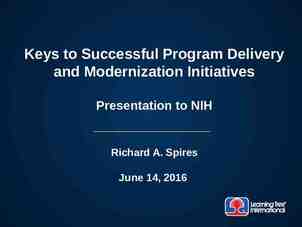New-Product Development & Product Life-Cycle Strategies
22 Slides96.14 KB
New-Product Development & Product Life-Cycle Strategies
New Product Development Process Idea Idea generation generation Idea Idea screening screening Concept Concept Development Development & & testing testing Business Business analysis analysis Product Product development development Test Test marketing marketing Marketing Marketing strategy strategy development development Commercialization Commercialization
New Product Development Process The systematic search for new product ideas. Idea Idea generation generation Idea Idea screening screening Concept Concept Development Development & & testing testing Business Business analysis analysis Product Product development development Test Test marketing marketing Marketing Marketing strategy strategy development development Commercialization Commercialization
New Product Development Process Screening new-product ideas in order to spot good ideas and drop poor ones as soon as possible. Idea Idea generation generation Idea Idea screening screening Concept Concept Development Development & & testing testing Business Business analysis analysis Product Product development development Test Test marketing marketing Marketing Marketing strategy strategy development development Commercialization Commercialization
New Product Development Process Development an attractive idea into a product concept which provides more detailed stated in meaningful consumer terms. Then test newproduct concepts with a group of target consumers to find out if the concepts have strong consumer appeal. Idea Idea generation generation Idea Idea screening screening Concept Concept Development Development & & testing testing Business Business analysis analysis Product Product development development Test Test marketing marketing Marketing Marketing strategy strategy development development Commercialization Commercialization
New Product Development Process Designing an initial marketing strategy for a new product based on the product concept. Idea Idea generation generation Idea Idea screening screening Concept Concept Development Development & & testing testing Business Business analysis analysis Product Product development development Test Test marketing marketing Marketing Marketing strategy strategy development development Commercialization Commercialization
Marketing Strategy Statement Consists of 3 parts: Target market The planned value proposition The sales, market share, and profit goals for the first few years.
Marketing Strategy Statement Example: electric car Product concept: A “green” car appealing to an environmentally conscious people who want practical, low polluting transportation. Marketing strategy statement: The target market is younger, well-educated, moderate-to high-income individuals, couples, or small families seeking practical, environmentally responsible transportation. The car will be positioned as more fun to drive and less polluting than today’s internal combustion engine or hybrid cars. The company will aim to sell 100,000 cars in the first year, at loss of not more than 15 million. In second year, the company will aim for sales of 120,000 cars and a profit of 25 million.
New Product Development Process Idea Idea generation generation Idea Idea screening screening Concept Concept Development Development & & testing testing Business Business analysis analysis Product Product development development Test Test marketing marketing A review of the sales, costs, and profit projections for new product to find out whether these factors satisfy the company’s objectives. Marketing Marketing strategy strategy development development Commercialization Commercialization
New Product Development Process Idea Idea generation generation Idea Idea screening screening Concept Concept Development Development & & testing testing Business Business analysis analysis Product Product development development Test Test marketing marketing Developing the product concept into a physical product in order to ensure that the product idea can be turn into a workable market offering. Marketing Marketing strategy strategy development development Commercialization Commercialization
New Product Development Process Idea Idea generation generation Idea Idea screening screening Concept Concept Development Development & & testing testing Business Business analysis analysis Product Product development development Test Test marketing marketing Marketing Marketing strategy strategy development development Commercialization Commercialization The stage of new-product development in which the product and marketing program are tested in realistic market settings.
New Product Development Process Idea Idea generation generation Idea Idea screening screening Concept Concept Development Development & & testing testing Business Business analysis analysis Product Product development development Test Test marketing marketing Marketing Marketing strategy strategy development development Commercialization Commercialization Introducing a new product into the market
Product Life-Cycle Strategies The course of a product’s sales and profits over its lifetime. It involves five distinct stages: 1. 2. 3. 4. 5. Product development Introduction Growth Maturity Decline
Sales & Profits over the Product’s Life from Inception to Decline Sales and profits ( ) 6 5 4 3 2 Sales Profits 1 0 -1 Time -2 Losses/ Investment ( ) This shows typical product life cycle (PLC), not all products follow this PLC.
Stage 1 Product development: Begins when company finds and develops a new-product idea. During this stage, sales are zero and the company’s investment costs add up.
Stage 2 Introduction: Starts when the new product is first launched. Is a period of slow sales growth as the product is introduced in the market. Profits are nonexistent or low in this stage because of the heavy expenses of product introduction.
Stage 3 Growth: Is a period of rapid market acceptance and increasing profits. Product’s sales start climbing quickly.
Stage 4 Maturity: Is a period of slowdown in sales growth because the product has achieved acceptance by most potential buyers. Profits level off or decline because of increased marketing outlays to defend the product against competition.
Stage 5 Decline: Is the period when sales fall off and profits drop. Sales decline for many reasons: technological advances, shifts in consumer tastes, and increased competition. – A firm must regularly review product sales, market shares, costs, and profit trends. Then, management can decide whether to maintain, harvest, or drop the declining products.
Summary of PLC Characteristics Characteristics Introduction Growth Maturity Decline Sales Low sales Peak sales Declining sales Costs Profits High cost per customer Negative Rapidly rising sales Average cost per customer Rising profits Low cost per customer High profits Customers Innovators Early adopters Competitors Few Growing number Middle majority Stable number begin to decline Low cost per customers Declining profits Laggards Declining number
Summary of PLC Objectives Marketing Objectives Introduction Growth Maturity Decline Create product awareness and trial Maximize market share Maximize profit while defending market share Reduce expenditure and milk the brand
Summary of PLC Strategies Strategies Introduction Growth Maturity Decline Product Offer a basic product Diversify brand and models Phase out weak items Price Use cost-plus Build selective distribution Price to match or beat competitors Build more intensive distribution Cut price Distribution Offer product extensions, service, warranty Price to penetrate market Build intensive distribution Advertising Build product awareness among early adopters and dealers Use heavy sales promotion to entice trial Build awareness and interest in the mass market Stress brand differences and benefits Reduce to take advantage of heavy consumer demand Increase to encourage brand switching Sales promotion Go selective: phase out unprofitable outlets Reduce to level needed to retain hard-core loyals Reduce to minimal level



























